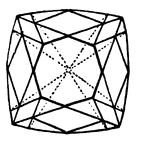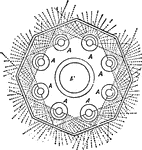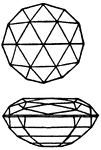The Lenses and Refraction ClipArt gallery offers 75 illustrations of light changing direction as it passes through media with different refractive indices.
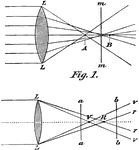
Aberration
"In optics, a deviation in the rays of light when unequally refracted by a lens or reflected…

Catadiopteric Light
"Catadioptric Fixed Light.—This apparatus, in which a central burner is used, consists of a dioptric…

Catadioptric Holophote
"Catadioptric Holophote.—Part of the anterior hemisphere of rays is intercepted and at once parallelized…

Chromatic Aberration
"Because of their greater refrangibility, the focus of the violet rays is nearer the lens than the focus…

Condensing Apparatus
"Condensing Apparatus for Steamer's Side Lights.—By means of this application of the condensing principle…
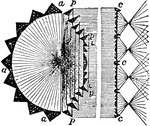
Condensing Light
"Fixed Conensing Light for a Single Sector, 1850.—The holophote Light pLp throws its whole light on…
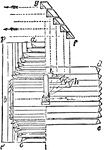
Condensing Octant
"Condensing Octant.—The central fixed apparatus bb with spherical mirror dd throws its rays directly…
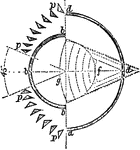
Condensing Octant
"Condensing Octant.—The central fixed apparatus bb with spherical mirror dd throws its rays directly…
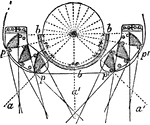
Condensing Quadrant
"Condensing Quadrant.—The fixed apparatus bbb, with spherical mirror behind, throws its rays directly…
Convex Lens
"A modification of the simple kaleidoscope was introduced by Sir David Brewster, whereby the images…
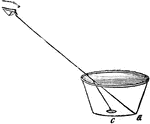
Cup and Shilling
"The refraction of water is beautifully proved by the following simple experiment. Place an empty cup,…
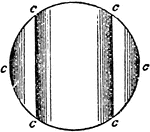
Differential Lens
"Differential Lens.—Horizontal divergence may be obtained to any required amount by varying the radius…

Differential Lens
"Differential Lens.—Horizontal divergence may be obtained to any required amount by varying the radius…
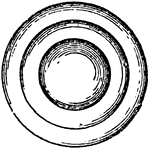
Differential Lens
"Differential Lens.—Horizontal divergence may be obtained to any required amount by varying the radius…
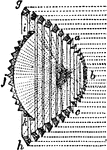
Dioptric Holophote
"Perfect Form of Dioptric Holophote for an Oil Flame.—By combining the back prisms ga, hc just described…
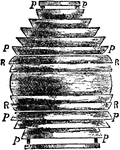
Dioptric Light
"First Application of Total Reflexion to Fixed Lights. In this apparatus Fresnel substituted his totally…
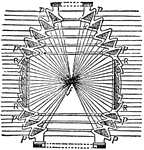
Fresnels Revolving Light
"Fresnel's Revolving Light. —In this form of revolving light the central burner is surrounded by annular…

Fresnels Revolving Light
"Fresnel's Revolving Light. —In this form of revolving light the central burner is surrounded by annular…

Fresnels Revolving Light
"Fresnel's Revolving Light. —In this form of revolving light the central burner is surrounded by annular…
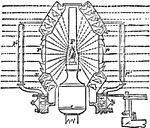
Fresnels Revolving Light
"Fresnel's Revolving Light. —In this form of revolving light the central burner is surrounded by annular…
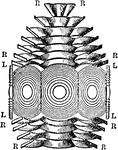
Holophotal Catadioptric
"Holophotal Catadioptric Apparatus Revolving round a Central Flame.—If in place of Fresnel's compound…

Holophotal Light
"Holophotal Fixed Light varied by Flashes.—Fresnel's double agents are here also dispensed with by…

Bernieres Immense Burning Glass
Bernieres Immense Burning Glass is an illustration found in an illustrated journal The "Wonders of Heat"…

Lens
"A lens is a transparent body the two refracting surfaces of which are curved, or one of which is curved…

Huyegenian Eyepiece Diagram Showing Lens Refraction
"They have also a shorter focus for red, and a longer one for blue, and thus magnify the red image more…

Ramsden Eyepiece Lens Refraction Diagram
"If the real image produced by the objective coincides with the collective lens, only the inclination…

Achromatic Lens
"A double convex lens of crown-glass may be combined with a plano-convex lens of flint-glass so as to…

Refraction of Light through Bi Convex Lens
"...let LN represent a glass biconvex lens, with centres of curvature at C and C', and AB, the incident…

Convex Lens
"When the object is at a long distance from the lens, the image formed is smaller than the object, and…
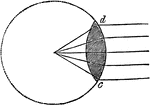
Double Convex Lens
"The shape of the double convex lens, d, c, is that of two plano-convex lenses, placed with their plane…

Double Convex Lens Magnifing an Arrow
"Double convex lenses are used in the eyeglasses for old people, becoming more spherical according to…

Double Convex Lens
"The double convex lens may be described as the part common to two spheres that intersect each other.…
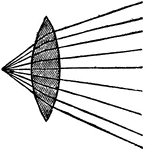
Converging Rays and a Double Convex Lens
"Thus the pencils of converging rays, are rendered still more convergent by their passage through the…

Diverging Rays from a Double Convex Lens
"If diverging rays fall on the surface of the same lens, they will, by refraction, be rendered less…
Light Correction of Blue and Red Lights using Spherical Lens
"Showing a system with chromatic difference of spherical aberration. O" ₌ image of O for red light;…
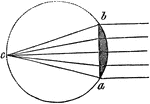
Plano Convex Lens
"If the whole circle be considered the circumfrence of a sphere, of which the plano-convex lens b, a,…

View of an Arrow Through a Plano Convex Lens
"View of an arrow through a plano convex lens will have the arrow appear smaller than it actually is."…
Lenses of Various Forms
"a, prism; b, plane glass; c, spherical lens; d, double-convex; e, plano-convex, f, double-concave;…
Magnification of Image Beyond Axis with Lens
"The lens is spherically corrected for OO', but the sinecondition is not fulfilled. Hens the different…
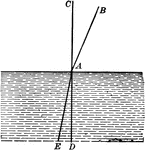
Atmospheric Optics
"BA is the ray of light passing through a rare medium (as, for instance, air); and upon its entrance…

Atmospheric Optics
The figure "illustrates the bending of the solar rays entering the atmosphere. When the sun is below…

Optical Position and Size of Image Through Magnifying Glasses
"If y be the object the image appears to a normal eye situated behind the system L with passive accommodation…

Porro Prism
Double Porro prism systems are used in small optical telescopes to re-orient an inverted image, and…

Prism
"A prism is a transparent body with two refraction surfaces that lie in intersecting planes. The angle…

Refraction
"The following simple experiment illustrates the effect of refraction:—Place a silver coin, m,…

Refraction of Light through Glass
"Illustrating refraction of light from a source through glass, and the appropriate angles of refraction."…

Refraction
"The stick AB appears bent at C, on account of the refraction caused by the water. The eye sees the…
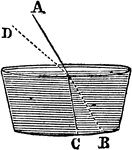
Refraction Between Mediums
"Since air is a rarer medium and water is denser, as ray A passes into the water, it is refracted to…
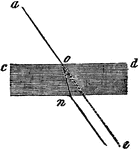
Refraction of Light
"Although a ray of light will pass in a straight line, when not interrupted, yet when it passes obliquely…

Refraction, air, water, glass
"Let a represent a, b water, and c a piece of glass. The ray d, striking each medium in a perpendicular…

Object Refracted through Biconvex Lens
"Showing how an object is refracted through a biconvex lens." -Avery 1895

Refraction by Plates
"When radiant energy passes through a medium bounded by parallel planes, the refractions at the two…

Refraction of Complimentary Colors
"The prism will deflect the red and orange, and form a reddish colored image at n. The violet, indigo,…
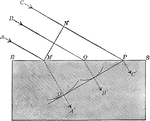
Explanation of Refraction
"Thus, when erher waves that constitute light are transmitted through glass, they are hindered by the…
